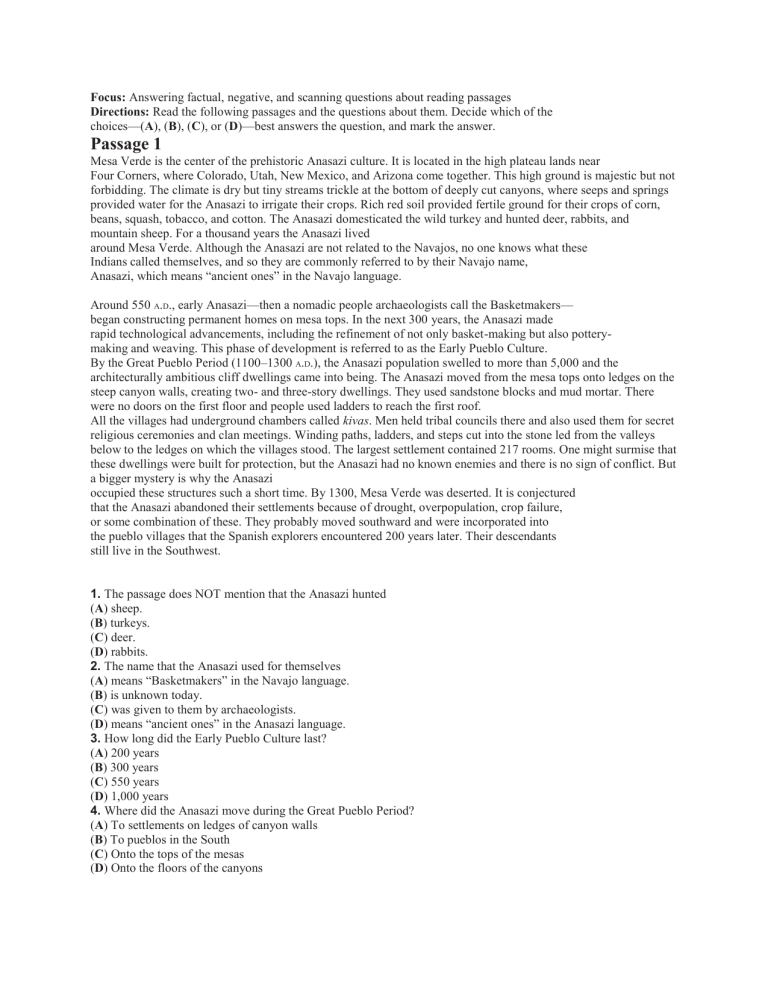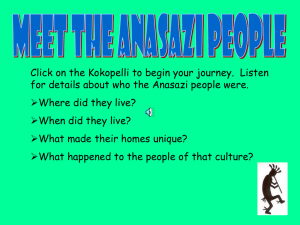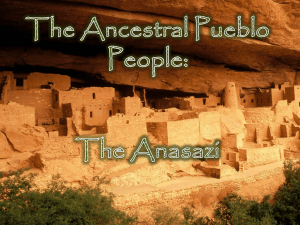Reading Comprehension: Passages & Questions

Focus: Answering factual, negative, and scanning questions about reading passages
Directions: Read the following passages and the questions about them. Decide which of the choices—( A ), ( B ), ( C ), or ( D )—best answers the question, and mark the answer.
Passage 1
Mesa Verde is the center of the prehistoric Anasazi culture. It is located in the high plateau lands near
Four Corners, where Colorado, Utah, New Mexico, and Arizona come together. This high ground is majestic but not forbidding. The climate is dry but tiny streams trickle at the bottom of deeply cut canyons, where seeps and springs provided water for the Anasazi to irrigate their crops. Rich red soil provided fertile ground for their crops of corn, beans, squash, tobacco, and cotton. The Anasazi domesticated the wild turkey and hunted deer, rabbits, and mountain sheep. For a thousand years the Anasazi lived around Mesa Verde. Although the Anasazi are not related to the Navajos, no one knows what these
Indians called themselves, and so they are commonly referred to by their Navajo name,
Anasazi, which means “ancient ones” in the Navajo language.
Around 550
A
.
D
., early Anasazi—then a nomadic people archaeologists call the Basketmakers— began constructing permanent homes on mesa tops. In the next 300 years, the Anasazi made rapid technological advancements, including the refinement of not only basket-making but also pottery- making and weaving. This phase of development is referred to as the Early Pueblo Culture.
By the Great Pueblo Period (1100–1300
A
.
D
.), the Anasazi population swelled to more than 5,000 and the architecturally ambitious cliff dwellings came into being. The Anasazi moved from the mesa tops onto ledges on the steep canyon walls, creating two- and three-story dwellings. They used sandstone blocks and mud mortar. There were no doors on the first floor and people used ladders to reach the first roof.
All the villages had underground chambers called kivas . Men held tribal councils there and also used them for secret religious ceremonies and clan meetings. Winding paths, ladders, and steps cut into the stone led from the valleys below to the ledges on which the villages stood. The largest settlement contained 217 rooms. One might surmise that these dwellings were built for protection, but the Anasazi had no known enemies and there is no sign of conflict. But a bigger mystery is why the Anasazi occupied these structures such a short time. By 1300, Mesa Verde was deserted. It is conjectured that the Anasazi abandoned their settlements because of drought, overpopulation, crop failure, or some combination of these. They probably moved southward and were incorporated into the pueblo villages that the Spanish explorers encountered 200 years later. Their descendants still live in the Southwest.
1. The passage does NOT mention that the Anasazi hunted
( A ) sheep.
( B ) turkeys.
( C ) deer.
( D ) rabbits.
2. The name that the Anasazi used for themselves
( A ) means “Basketmakers” in the Navajo language.
( B ) is unknown today.
( C ) was given to them by archaeologists.
( D ) means “ancient ones” in the Anasazi language.
3. How long did the Early Pueblo Culture last?
( A ) 200 years
( B ) 300 years
( C ) 550 years
( D ) 1,000 years
4. Where did the Anasazi move during the Great Pueblo Period?
( A ) To settlements on ledges of canyon walls
( B ) To pueblos in the South
( C ) Onto the tops of the mesas
( D ) Onto the floors of the canyons
5. According to the passage, the Anasazi buildings were made primarily of
( A ) mud.
( B ) blocks of wood.
( C ) sandstone.
( D ) the skins of animals.
6. According to the passage, the Anasazi entered their buildings on the ledges
( A ) by means of ladders.
( B ) from underground chambers.
( C ) by means of stone stairways.
( D ) through doors on the first floor.
7. According to the passage, kivas were used for all the following purposes EXCEPT
( A ) clan meetings.
( B ) food preparation.
( C ) religious ceremonies.
( D ) tribal councils.
8. According to the passage, the LEAST likely reason that the Anasazi abandoned Mesa Verde was
( A ) drought.
( B ) overpopulation.
( C ) war.
( D ) crop failure.
9. Put an X next to the paragraph that presents theories about why the Anasazi left.
Passage 2
Dulcimers are musical instruments that basically consist of wooden boxes with strings stretched over them. In one form or another, they have been around since ancient times, probably originating with the Persian santir. Today there are two varieties: the hammered dulcimer and the Appalachian, or mountain dulcimer. The former is shaped like a trapezoid, has two or more strings, and is played with wooden mallets. It is the same instrument played in a number of
Old World countries. The Appalachian dulcimer is classified by musicologists as a box zither. It is a descendant of the Pennsylvania Dutch scheitholt and the French epinette. Appalachian dulcimers are painstakingly fashioned by artisans in the mountains of West Virginia, Kentucky,
Tennessee, and Virginia. These instruments have three or four strings and are plucked with quills or the fingers. They are shaped like teardrops or hourglasses. Heart-shaped holes in the sounding board are traditional. Most performers play the instruments while seated with the instruments in their laps, but others wear them around their necks like guitars or place them on tables in front of them. Originally used to play dance music, Appalachian dulcimers were popularized by performers such as John Jacob Niles and Jean Ritchie during the folk music revival of the
1960s.
10. According to the passage, which of the following is NOT an ancestor of the Appalachian dulcimer?
( A ) The box zither
( B ) The santir
( C ) The scheitholt
( D ) The epinette
11. According to the passage, how many strings does the Appalachian dulcimer have?
( A ) One or two
( B ) Three or four
( C ) Four or five
( D ) Six or more
12. According to the passage, a hammered dulcimer is made in the shape of a(n)
( A ) hourglass.
( B ) heart.
( C ) trapezoid.
( D ) teardrop.
13. According to the author, most performers play the Appalachian dulcimer
( A ) while sitting down.
( B ) with the instrument strapped around their neck.
( C ) while standing at a table.
( D ) with wooden hammers.
14. According to the author, what are John Jacob Niles and Jean Ritchie known for?
( A ) Playing dance music on Appalachian dulcimers
( B ) They are artisans who design Appalachian dulcimers
( C ) They helped bring Appalachian dulcimers to the public’s attention
( D ) They began the folk music revival of the 1960s
15. Underline the sentence in the passage that tells where Appalachian dulcimers are made.
Passage 3
Humanitarian Dorothea Dix was born in Hampden, Maine, in 1802. At the age of 19, she established a school for girls, the Dix Mansion School, in Boston, but had to close it in 1835 due to her poor health. She wrote and published the first of many books for children in 1824. In
1841, Dix accepted an invitation to teach classes at a prison in East Cambridge, Massachusetts. She was deeply disturbed by the sight of mentally-ill people thrown in the jail and treated like criminals. For the next eighteen months, she toured Massachusetts institutions where other mental patients were confined and reported the shocking conditions she found to the state legislature. When improvements followed in Massachusetts, she turned her attention to the neighboring states and then to the West and South. Dix’s work was interrupted by the Civil
War; she served as superintendent of women hospital nurses for the federal government. Dix saw special hospitals for the mentally ill built in some fifteen states. Although her plan to obtain public land for her cause failed, she aroused concern for the problem of mental illness all over the United States as well as in Canada and Europe. Dix’s success was due to her independent and thorough research, her gentle but persistent manner, and her ability to secure the help of powerful and wealthy supporters.
16. In what year was the Dix Mansion School closed?
( A ) 1821
( B ) 1824
( C ) 1835
( D ) 1841
17. Underline the sentence in the first paragraph that explains why Dorothea Dix first went to a prison.
18. Where was Dorothea Dix first able to bring about reforms in the treatment of the mentally ill?
( A ) Canada
( B ) Massachusetts
( C ) The West and South
( D ) Europe
19. Dorothea Dix was NOT successful in her attempt to
( A ) become superintendent of nurses.
( B ) publish books for children.
( C ) arouse concern for the mentally ill.
( D ) obtain public lands.
20. Underline the sentence in paragraph 2 in which the author gives specific reasons why Dix was successful.
Passage 4
Ambient divers are, unlike divers who go underwater in submersible vehicles or pressure resistant suits, exposed to the pressure and temperature of the surrounding ( ambient ) water.
Of all types of diving, the oldest and simplest is free diving. Free divers may use no equipment at all, but most use a face mask, foot fins, and a snorkel. Under the surface, free divers must hold their breath. Most free divers can only descend 30 to 40 feet, but some skilled divers can go as deep as 100 feet. Scuba diving provides greater range than free diving. The word scuba stands for s elf c ontained u nderwater b reathing a pparatus.
Scuba divers wear metal tanks with compressed air or other breathing gases. When using open-circuit equipment, a scuba diver simply breathes air from the tank through a hose and
releases the exhaled air into the water. A closed-circuit breathing device, also called a rebreather, filters out carbon dioxide and other harmful gases and automatically adds oxygen.
This enables the diver to breathe the same air over and over. In surface-supplied diving, divers wear helmets and waterproof canvas suits. Today, sophisticated plastic helmets have replaced the heavy copper helmets used in the past. These divers get their air from a hose connected to compressors on a boat. Surface-supplied divers can go deeper than any other type of ambient diver.
21. Ambient divers are ones who
( A ) can descend to extreme depths.
( B ) use submersible vehicles.
( C ) use no equipment.
( D ) are exposed to the surrounding water.
22. According to the passage, a free diver may use any of the following EXCEPT
( A ) a rebreather.
( B ) a snorkel.
( C ) foot fins.
( D ) a mask.
23. According to the passage, the maximum depth for free divers is around
( A ) 40 feet.
( B ) 100 feet.
( C ) 200 feet.
( D ) 1,000 feet.
24. When using closed-circuit devices, divers
( A ) exhale air into the water.
( B ) hold their breath.
( C ) breathe the same air over and over.
( D ) receive air from the surface.
25. According to the passage, surface-supplied divers today use helmets made from
( A ) glass.
( B ) copper.
( C ) plastic.
( D ) canvas.
26. Underline the sentence in paragraph 3 that explains how surface-supplied divers are able to breath.








